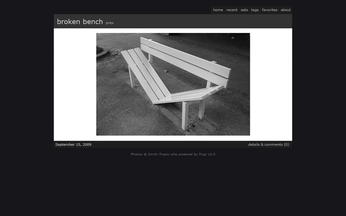Flogr: Flickr Your Way

Productivity Sauce
Flickr is, without doubt, an excellent service for shutterbugs and professional photographers alike, but if you are looking for a more streamlined interface that makes it easier for you to view and manage your precious shots, you might want give Flogr a try.
This PHP-powered application doesn't add new functionality, but rather makes essential features more accessible and wraps them into a slick and easy-to-use interface. To install Flogr, you need a server running Apache and PHP. Grab the latest version of the application from the project's Web site, unpack the downloaded archive, and move the resulting directory into the document root of your server. Next, you have to obtain your Flickr ID which Flogr uses to pull your Flickr data. The easiest way to find out your Flickr ID is to use the idGettr service. Enter the http://www.flickr.com/photos/username/ URL into the Photostream address field (replace username with your actual Flickr user name) and hit the Find button. You should see your ID which looks like this: 82643076@N00. Open the admin/config.php file in a text editor and locate the following line:
REQUIRED_SETTING('FLICKR_USER_ID', '');Add the obtained Flickr ID to it:
REQUIRED_SETTING('FLICKR_USER_ID', '82643076@N00');This is the only mandatory settings you have to specify, but you might as well configure other options while at it. By default, Flogr fetches the large versions of your photos, which can be rather slow. To speed things up, locate the following option and change Original to Medium:
REQUIRED_SETTING('FLOGR_PHOTO_QUALITY', 'Original');To improve Flogr performance, you can use a MySQL database for caching data. In this case, you have to specify the database connection settings using the following options:
OPTIONAL_SETTING('CACHE_SQL_USER', '');
OPTIONAL_SETTING('CACHE_SQL_PASSWORD', '');
OPTIONAL_SETTING('CACHE_SQL_SERVER', '');
OPTIONAL_SETTING('CACHE_SQL_DATABASE', '');
OPTIONAL_SETTING('CACHE_PATH', '');Once you're satisfied with the settings, save the config.php file, and point your browser to http://yourserver/flogr. The landing page displays your recent photos as a gallery and you can navigate through it using the Next and Previous buttons. Click on the Details & Comments link, and a photo details overlay displays description, EXIF data, tags, and comments. You can also view the most recent photos as a thumbnail collection by clicking on the Recent link. You can then click on the thumbnail you like to view a larger version of the photo. The Tags link displays a tag cloud with clickable tags, and you can use it to display photos containing a specific tag. Finally, the Sets and Favorites links provide quick access to your photo sets and photos marked as favorites.
As you see, there is nothing earth-shattering about Flogr, yet its interface is so slick and intuitive that once you've tried it, chances are you will keep coming back to it.
comments powered by DisqusSubscribe to our Linux Newsletters
Find Linux and Open Source Jobs
Subscribe to our ADMIN Newsletters
Support Our Work
Linux Magazine content is made possible with support from readers like you. Please consider contributing when you’ve found an article to be beneficial.

News
-
So Long, ArcoLinux
The ArcoLinux distribution is the latest Linux distribution to shut down.
-
What Open Source Pros Look for in a Job Role
Learn what professionals in technical and non-technical roles say is most important when seeking a new position.
-
Asahi Linux Runs into Issues with M4 Support
Due to Apple Silicon changes, the Asahi Linux project is at odds with adding support for the M4 chips.
-
Plasma 6.3.4 Now Available
Although not a major release, Plasma 6.3.4 does fix some bugs and offer a subtle change for the Plasma sidebar.
-
Linux Kernel 6.15 First Release Candidate Now Available
Linux Torvalds has announced that the release candidate for the final release of the Linux 6.15 series is now available.
-
Akamai Will Host kernel.org
The organization dedicated to cloud-based solutions has agreed to host kernel.org to deliver long-term stability for the development team.
-
Linux Kernel 6.14 Released
The latest Linux kernel has arrived with extra Rust support and more.
-
EndeavorOS Mercury Neo Available
A new release from the EndeavorOS team ships with Plasma 6.3 and other goodies.
-
Fedora 42 Beta Has Arrived
The Fedora Project has announced the availability of the first beta release for version 42 of the open-source distribution.
-
Dash to Panel Maintainer Quits
Charles Gagnon has stepped away as maintainer of the popular Dash to Panel Gnome extension.

